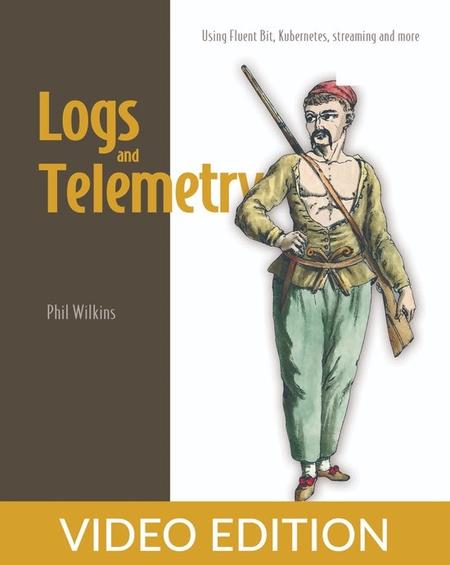English | MP4 | AVC 1280×720 | AAC 44KHz 2ch | 10h 6m | 1.69 GB
Build cloud native observability pipelines with minimal footprints and high-performance throughput—all with Fluent Bit, Kubernetes, and your favorite visualization and analytics tools.
Logs and Telemetry is an all-practical guide to monitoring both cloud-native and traditional environments with the Fluent Bit observability tool. It takes you from the basics of collecting app logs, all the way to filtering, routing, enriching and transforming logs, metrics, and traces.
Inside Logs and Telemetry you’ll learn how to:
- Deploy Fluent Bit for telemetry (log, metric, and trace) collection
- Configure pipelines to filter, route, and transform data
- Integrate Fluent Bit with containers and Kubernetes
- Configure Fluent Bit to work with OpenTelemetry, Prometheus, and other open source tech
- Monitor applications at scale with minimal footprint
- Address challenges in Kubernetes-based ecosystems using Fluent Bit
- Utilize Fluent Bit for real-time event analytics to derive new metrics and insights
- Develop custom filters, inputs, and outputs for unique or reusable use cases
Logs and Telemetry draws on both the input and support of key committers and founders of Fluent Bit, and author Phil Wilkins’ years of experience in DevOps. Inside, you’ll see how you can integrate Fluent Bit with Prometheus, OpenTelemetry, FluentD deployments, and more. Learn how Fluent Bit can not only meet all the demands of cloud-native use cases, but also more traditional deployments as well.
Fluent Bit is a super-fast lightweight observability tool that’s perfect for Kubernetes and containers, as well as traditional IT environments. Fluent Bit makes it a snap to extract meaning from the logs, traces, and other performance metrics generated by your applications and infrastructure. It’s also a great way to route telemetry to analysis tools like Prometheus and Grafana.
Logs and Telemetry shows you how to turn systems data into actionable insights using Fluent Bit. You’ll start by learning the pre-built plugins for common use cases and progress to integration with powerful tools like OpenTelemetry and real-time analytical event processing. You’ll use plugins to configure routing, filtering and processing, automate your observability with Lua scripts, and configure Fluent Bit to meet the demands of highly scalable environments.
What’s inside
- Deploy Fluent Bit for telemetry collection
- Configure pipelines to filter, route, and transform data
- Integrate Fluent Bit with containers and Kubernetes
- Monitor applications at scale
Table of Contents
Chapter 1. Introduction
Chapter 1. How telemetry is consumed by different teams
Chapter 1. Challenges facing telemetry systems
Chapter 1. What you will learn
Chapter 1. Summary
Part 1. Telemetry system architecture
Chapter 2. The Emitting stage: Creating and submitting telemetry
Chapter 2. Emitting from hardware
Chapter 2. Emitting from as-a-Service systems
Chapter 2. Summary
Chapter 3. The Shipping stage: Moving and storing telemetry
Chapter 3. Shipping between SaaS systems
Chapter 3. Tipping points in Shipping-stage architecture
Chapter 3. Summary
Chapter 4. The Shipping stage: Unifying diverse telemetry formats
Chapter 4. Unifying diverse emitting formats
Chapter 4. Summary
Chapter 5. The Presentation stage: Displaying telemetry
Chapter 5. Displaying telemetry in centralized logging systems
Chapter 5. Displaying telemetry in security systems
Chapter 5. Displaying telemetry distributed tracing systems
Chapter 5. Displaying telemetry in large organizations
Chapter 5. Summary
Chapter 6. Marking up and enriching telemetry
Chapter 6. Markup and enrichment in the Shipping stage
Chapter 6. Enrichment in the Presentation stage
Chapter 6. How telemetry style affects markup and enrichment
Chapter 6. Summary
Chapter 7. Handling multitenancy
Chapter 7. Designing multitenant telemetry systems
Chapter 7. Summary
Part 2. Use cases revisited: Applying architecture concepts
Chapter 8. Growing cloud-based startup
Chapter 8. Telemetry at the medium-size company stage
Chapter 8. Telemetry at the large-company stage
Chapter 8. Telemetry at the enterprise stage
Chapter 8. Looking back at all this growth
Chapter 8. Summary
Chapter 9. Nonsoftware business
Chapter 9. Telemetry use in medium-size organizations
Chapter 9. Telemetry use in large organizations
Chapter 9. Telemetry use in enterprise organizations
Chapter 9. Summary
Chapter 10. Long-established business IT
Chapter 10. Telemetry use in large organizations
Chapter 10. Telemetry use in global organizations
Chapter 10. Summary
Part 3. Techniques for handling telemetry
Chapter 11. Optimizing for regular expressions at scale
Chapter 11. Building expressions to fail fast
Chapter 11. Digging into the Cisco ASA firewall telemetry
Chapter 11. Refining emissions to speed regular-expression performance
Chapter 11. Additional regular-expression resources
Chapter 11. Summary
Chapter 12. Standardized logging and event formats
Chapter 12. Implementing standards in your code
Chapter 12. Implementing standards in the Shipping stage
Chapter 12. Summary
Chapter 13. Using more nonfile emitting techniques
Chapter 13. Emitting and shipping for container- and serverless-based code
Chapter 13. Encrypting UDP-based telemetry
Chapter 13. Summary
Chapter 14. Managing cardinality in telemetry
Chapter 14. Lowering the cost of cardinality
Chapter 14. Summary
Chapter 15. Ensuring telemetry integrity
Chapter 15. Making telemetry harder to mess with
Chapter 15. Summary
Chapter 16. Redacting and reprocessing telemetry
Chapter 16. Redacting toxic information spills
Chapter 16. Reprocessing telemetry to support upgrades
Chapter 16. Isolating toxic data to reduce cleanup costs
Chapter 16. Summary
Chapter 17. Building policies for telemetry retention and aggregation
Chapter 17. Creating an aggregation policy
Chapter 17. Using sampling to reduce costs and increase retention
Chapter 17. Summary
Chapter 18. Surviving legal processes
Chapter 18. Dealing with records-retention requests
Chapter 18. Dealing with document-production requests
Chapter 18. Working with lawyers
Chapter 18. Summary
Appendix A. Telemetry storage systems
Appendix A. Analyzing Apache Cassandra
Appendix A. Analyzing Grafana Labs’ Loki
Appendix A. Analyzing MongoDB
Appendix A. Analyzing Prometheus
Appendix A. Analyzing InfluxDB
Appendix A. Analyzing Jaeger
Appendix B. Recommendation checklist reference
Appendix B. Presentation-stage recommendations
Appendix B. Cardinality management
Appendix B. Telemetry safety and effects
Appendix B. Legal topics
Appendix C. Exercise answers
Resolve the captcha to access the links!
